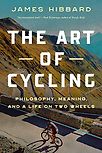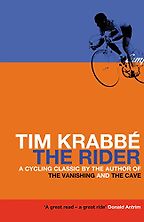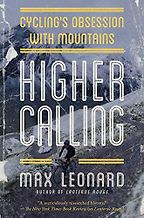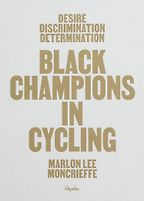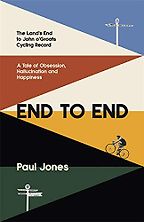Before we get to the books you’ve chosen, let’s talk in general about cycling. Briefly, what’s your personal background in the sport?
I was a US-based professional cyclist. I did mostly track cycling for the US cycling team, and was part of what were called ‘division three’ or ‘Continental’ teams. So I was a competent American professional, but my physical abilities were frankly limited and I always had the idea of going to graduate school for philosophy once I stopped racing. I studied it as an undergraduate at the University of California at Santa Cruz, and then under the Heidegger scholar and translator Will McNeill at DePaul University.
And you wrote about both in your book, The Art of Cycling.
I did. What compelled me to write the book was thinking through my relationship to both cycling and philosophy. There are competing threads to the narrative: one is personal—my experience as an athlete, the friendships I formed, and how I started to ride again in order to prepare for a ride down the California coast.
The other thread of the book is essentially a history of Western philosophy and how a specific tradition of metaphysics is at once tempting and dangerous—the sort of critique that Nietzsche makes that philosophy is “life denying” is something I wanted to explore against the backdrop of something as physical and embodied as cycling is. I was really influenced by road trip books like Zen and the Art of Motorcycle Maintenance by Robert Pirsig, which I’ve always had a real affinity for, and also Jack Kerouac’s On the Road—the sorts of books that fuse a very California ideal, the road trip, with philosophical reflections and an understanding of the role played by the landscape.
All of these things are commingled. My intent was a rather ambitious one, which is to describe what feels to me like the deep failure of Western metaphysics. That’s what I wanted to attack—this more cerebral view of what it is to be human by having this immediate lived experience as a counterpoint, of being on the bike and all of its visceral physicality. I wanted to address this through the work of not only Nietzsche, but also Heidegger, Carnap, Beauvoir, Camus, and other figures who show how thinking, when divorced from the physicality of our existence, fails—because I very much felt that it failed me.
As you say, there are different threads to the book. There’s the straight story about your experience as a professional cyclist and how you came to reach that level. Then there’s you rediscovering cycling by going on a road trip, with some ex-professional cyclists. That road trip is the core of the book that you keep returning to. Intermingled with that is the philosophy that relates to the body in motion. So three different ways of thinking about cycling in a memoir. You obviously think very hard about cycling. I’m really interested in the way in which the bike almost becomes part of you. You sense if a saddle is a few millimetres out of place, almost as if it was your toe. It’s proprioception, almost, as if the bike has become so much part of you that you’re interacting with the world through what you feel through it.
I think that comes with 10,000 hours and more of being exposed to doing something so repetitive as cycling. The whole idea of where your body’s limits are in becoming highly skillful at something isn’t necessarily just about cycling. Frankly, there are any number of tangible activities that would have allowed for the book that I wanted to write. I think that much the same holds for pottery or playing the violin, that bodily relationship with a tool gives this immediate presence that runs counter to brain-in-a-vat type conceptions of thinking. You’re drawn out of your mind. Everyone claims they’re no longer Cartesian dualists and that we’ve transcended that thinking, but in a lot of ways, I think that as we’ve moved towards a detached and virtual society, you still have many people who are, effectively, Cartesian dualists who spend their time in their head on the internet doing abstract tasks. Cycling and your relationship to the bicycle is one way—among many others—in avoiding that situation, which I think is on the whole a destructive one.
We don’t want to get too far away from cycling and too much into philosophy, but the easiest explanation of why philosophy has got a tendency to be cerebral is that the people who do it do it verbally. They might as well be brains in vats, a lot of them. And the people who are cycling or doing high-level sport typically aren’t also philosophers, although there are a few exceptions. That’s where that strange mismatch has come from. But there are thinkers—like Gilbert Ryle, for instance—who have been sensitive to the difference between knowing that and knowing how, the sense in which you can display bodily intelligence at a very high level without articulating everything and thinking in terms of abstract concepts.
Yes, and Martin Heidegger’s discussion of tools is very appropriate here. Heidegger never mentioned cycling, per se. I know biographically that Heidegger skied, and he has a few essays about skiing. You can imagine him skiing towards his hut. In general, Heidegger has a rather sophisticated description of our relationship to tools, the famous bit in Being and Time about the hammer. So there certainly are some philosophers who are more sophisticated in terms of their understanding of the bodily and embodied existence. But, as a rule of thumb, moving through history from Plato, there’s certainly that tendency which I was interested in discussing and using my experience as a cyclist to push against.
“I want everything that I’ve selected to be accessible—regardless of your level of knowledge of the sport”
Another interesting thing that has happened is that people often think of academic philosophy as being marginalized and not particularly useful—the queen of the dead and dying humanities. However, as I was writing this book and thinking about some of the intellectual habits of abstraction which originate in Western metaphysics, I realized the extent to which many of those habits—in terms of intellectual detachment and a value for the novel and ideal—are exceptionally prevalent and only growing more so with new technology. That’s the other thing to consider about what we are discussing—the narrative whereby philosophy and some of the philosophical habits that you or I can see and identify are, in fact, far more prevalent than people give them credit for in a detached and virtual world where so many people aspire to knowledge work.
Let’s turn to the five books you’ve chosen about cycling. First of all, is cycling a rich area for books? There are some areas of sport, like boxing, where there are numerous examples of very high-quality writing. Has cycling produced good writing?
It’s produced some exceptional writing. The way I’ve conceptualized the books, these cycling titles, is that there are books that are very, very high quality, but perhaps only about a particular event, or a particular rider. I’ve omitted some of those jewels for reasons of breadth and scope. I want everything that I’ve selected to be accessible—regardless of your level of knowledge of the sport. So, there’s a brilliant book by Paul Kimmage about doping in sport, called Rough Ride. It’s not on my list, but if you’re a fan of cycling, it’s an absolutely incredible book. There are some other biographies that are simply amazing, including Phil Gaimon’s book Draft Animals and Graeme Obree’s book, Flying Scotsman.
There are also some histories of the Tour de France, the Giro d’Italia, and the other grand tours that are stunning, like Three Weeks, Eight Seconds by Nige Tassell. However, what I’ve aimed for, in terms of the writing that I’ve selected, are books where the sport of cycling is an anchor or point of departure for a more subtle discussion of something which transcends sport. That’s how I’ve tried to approach what I’ve selected and what I’ve looked for.
The first book you’ve chosen is The Rider by Tim Krabbé. Could you describe it?
This book was written in the late 1970s. Tim Krabbé is Dutch and the book wasn’t translated into English until the early 2000s. He’s an avid chess player, cyclist, polymath, just an all-around interesting person. He’s about to turn 80, and essentially what The Rider is is a direct—I daresay phenomenological—account of what it’s like to be in this bike race in the Netherlands. It’s absolutely fictionalized. This is not a particular race, not a particular rider, the names have been changed, although Krabbé himself appears as a competitor and we see the race from his perspective. Everything is very immediate, very visceral. It’s a description of, ‘this breakaway has gone up the road, the rain has started to pound and I can’t feel my fingertips on the brake levers.’ There’s a very cult-like immediacy to how he approaches the sport.
The writing is phenomenal. What it reminds me of, more than anything else, is Albert Camus’ fiction. You think of the opening line of The Stranger, the very famous one, “Mother died today. Or maybe it was yesterday, I don’t know.” There’s a similar bit as soon as you get going in The Rider: “Tourists and locals are watching from sidewalk cafés. Non-racers. The emptiness of those lives shocks me.” I read Camus before reading The Rider, but as soon as I read The Rider, I thought, ‘this is the cycling novel that Camus would have written.’ It’s an incredible piece of writing. I think that among most cycling aficionados, it’s ranked as the most literary and most highly regarded cycling novel—to the point where it has perhaps blotted out other interesting writing on the sport.
It’s great that you’re recommending it as an ex-pro rider, because a lot of people who write about sports in fiction or make films about it, don’t get it quite right.
Yes. Films and cycling in particular are a tricky business. There are so many that I’ve seen where the jerseys are wrong, or it doesn’t ring true. Everything rings true with The Rider and that’s what makes it such an interesting accomplishment. And it’s not just a matter of strict accuracy and verisimilitude, it also gets the psychology right. That line that I alluded to earlier, this feeling of exclusivity: this undertaking is difficult but elective, and everyone else seems like a civilian by contrast.
It’s only about 150 pages long, depending on the edition. It’s almost a novella.
Yes. It has got that novella immediacy to it. There’s not a lot of back story. There’s nothing bogging it down, trying to impress his reader or anything like that. This is direct, immediate experience of what it is to race a bicycle.
How did you come across it?
I actually can’t recall. I think it was one of those books I came across because it was circulated amongst racers with literary proclivities. That, in and of itself, is a testament to its general authenticity.
Let’s go on to the second cycling book you’ve chosen which is What Goes Around by Emily Chappell. She was a courier rider in London.
Yes. Back in the late 1990s—before the internet, before attachments and Dropbox and downloads— there was a cycle courier culture in most major cities. They often rode fixed gear bicycles. There was an urban bent to cycle couriers, and some transitioned to becoming velodrome track racers because of their experience on fixed gear bicycles.
What is really compelling about this book is that she gets the landscape of London right. She accomplishes beautiful literary writing, that really captures this idea that when you’re on a bicycle, a city is not mediated. What I mean by that is this: when you’re on a bus, when you’re in a car, you’ve got glass, you’ve got enclosures that protect you—from the smell of back alleyways, from being exposed to unpleasant things—in a way that the bicycle simply does not. She doesn’t use the word, but it’s about how insulated and frictionless our life is designed to be now, and how being on a bicycle pushes against that.
Get the weekly Five Books newsletter
To illustrate that, you can think of the example of driving two different types of automobiles. One is a 1960s convertible with a manual transmission and no power steering, and you can feel everything that’s happening. The other is something like a Tesla, where you’ve got power steering, and everything is mediated through a computer to the point of it being self-driving. By design, you really don’t know what’s happening because there are all these interfaces. You can think of modern technological life generally as erring towards this sort of mediated, frictionless relationship to reality. Being on a bicycle in London, as she describes it, is the antithesis of that. Stopping and knowing a particular park bench in Hyde Park. She gets a lot about landscape and cycling very, very right.
It’s her memoir and just about being a courier?
Yes. She’s not a racer, she’s got a job to do. She’s got deadlines, she’s walking up to office buildings and delivering blueprints and plans. It’s very much a specific cycling subculture that she taps into, with this aim of describing her affinity for London and this proximal access to a city that you’re granted by being on a bike that you miss out on in any other form of conveyance.
When you’re racing, do you have that kind of awareness? Or are you just looking at the person in front of you?
It’s more of the person in front of you, to be honest. I wish I could say something romantic, Nigel, but no, it’s staring at the wheel in front of you and knowing what’s happening up the road in a particular breakaway and who’s motivated to chase down said breakaway. So there is a strategic macro view, but there certainly isn’t any noticing the countryside.
What about in training?
Training is very different, particularly when you’re going out to do a long aerobic base ride alone. I have very fond memories of training alone in the Santa Cruz mountains in the Bay Area in California. Those situations are very different: you do notice and are struck by the silence and beauty of the situation in a way that you never would be in a competitive situation. Reflecting back, I think I perhaps preferred training over racing, which is an odd thing to say for someone who’s ostensibly in that line of work.
Let’s move on to your third book, Higher Calling: Cycling’s Obsession with the Mountains by Max Leonard.
The reason this is an interesting book is twofold. The mountains in cycling, in competitive racing, hold a particularly prominent position. In grand tours like the Tour de France, it’s the mountains that separate the overall contenders, the people who are apt to win the race from everyone else. I was a sprinter and a track racer and an absolutely abysmal climber. Here, I’m speaking from a position as a fan of the sport and certainly not as someone who is a capable climber myself.
When you think about the time differences that manifest in a stage race, all that happens in the mountains where a leader will put five, seven minutes over his rivals in a stage. And when you rattle off the iconic stages of the Tour de France, the Giro d’Italia, the Vuelta a España, they’re all mountain stages, like Alpe d’Huez. Whether it’s the Alps or the Pyrenees, you can imagine these moon-like, barren landscapes, above the tree line, and riders emerging from small groups to really punish themselves. You can even think back to a rider like Tom Simpson. Certainly, amphetamines were involved, but back in the 60s, he died on the slopes of the mountain climb from the combination of amphetamines and exhaustion—literally riding himself to death.
It’s true that the mountains reveal just how exceptional some cyclists are, and what a sporting phenomenon it is that they can take on something that requires such effort and sustain that effort for hours. It’s stunning. They’re like another species almost.
Yes, climbers certainly are physiologically very different from a sprinter or time trialist. It’s a niche facet of the sport unto itself. But Higher Calling is not just a book about climbing or climbers, it’s also about the continental European mountains. Leonard does this beautifully. He opens the book with the snow being cleared on this mountain pass and closes the book with it being snowed in again. This road is only available for a very limited number of months during peak summer so there is this finite temporal element to it.
Riding on these roads, he is a reflective enough person to raise the basic question, ‘Why is this road even here?’ So, very quickly, you see concrete and battlements from World War II. You unpack the history of the Alps as a border between France and Italy going back to the Napoleonic Wars, when many of these roads that were initially dirt tracks were paved or became passable. So there’s a military and historical element to it. He does a wonderful job of unpacking the mountains as a place and figuring out why they hold this mythos, this appeal for cyclists. We’ve talked about some of the cycling elements already, but there are fascinating historical elements woven in.
Does he discuss what to me is the most terrifying aspect of this, which is the descent? It’s one thing to go up the mountain but the speed some cyclists come down the mountain is absolutely awe-inspiring.
He does somewhat. The descending becomes a little bit easy to take for granted among the skills that are involved in road cycling. When you start to look at it, it’s quite frightening and periodically— probably every other year—there’s a death of a professional cyclist, and it does tend to be on the descents. Very famously, before helmets were compulsory, the Olympic champion, an Italian by the name of Fabio Casartelli, died on a descent in the Tour de France.
When you think about the speeds that cyclists are traveling at on a descent like that, 100 kilometres an hour is not unreasonable. Now crash helmets are mandated, thankfully, but you’re still in Lycra shorts and a jersey. If you compare that to Moto GP or F1 and how protected they are, yes, the speeds are higher, but levels of protection are also astronomically better, and certainly not proportionate to what’s happening on a bicycle.
It’s one thing to come down that mountain but to race down is an act of real courage.
I’ve ridden in the Alps and Pyrenees though not in a race situation, and I’ve ridden in the Rockies in a race situation. Oddly, at least when one is 19 or 25 years old, it almost doesn’t cross your mind. But when one is 40 years old and a father, one’s attitude to such things shifts radically. That youthful bravado or nerve, where I didn’t even consider descending as being particularly hazardous, is long past for me personally.
Let’s move on to Desire, Discrimination, Determination: Black Champions in Cycling by Marlon Moncrieffe, a former road and track cyclist, but now an academic.
It’s undeniable that when you look at the history of cycling, there have been a number of amazing Afro-Caribbean athletes in the UK and African American athletes in the United States who have faced an uphill battle in terms of accessibility and outright discrimination in the sport. What Desire, Discrimination, Determination seeks to accomplish is to tell us some of the stories of black athletes that have been under-regarded in the past.
There are a number of American riders, stretching back to probably most famously, Major Taylor (1878-1932), who was the first African American world cycling champion. He was physically talented, exceptionally famous, and, interestingly, speaks to an era in the United States when not so much road cycling, but the sport of track cycling—indoor racing on velodromes—eclipsed even baseball and American football as the most watched spectator sport. Madison Square Garden in New York City was actually built for the sport of track cycling. So there’s a whole history that Major Taylor embodies—not just his success as an African American and what he faced to accomplish that, but also an entire era of the sport that’s been largely forgotten.
“Madison Square Garden in New York City was actually built for the sport of track cycling”
There are some interesting historical reasons for that. First of all, the roads and the derailleurs necessary to race road bikes had not really been invented. Secondly, from the turn of the century running through to the 1930s, there was an obsession with indoor marathon events. There’s a cultural aspect to it. They’ve morphed into what are now called six-day bicycle races, but they were conceived in the same spirit as dancing for six days or any other of these feats of endurance from that era, including riding your bike for six days on velodromes. Major Taylor, although himself a sprinter, was certainly involved in the spectacle of the sport during that period of time.
Is this a history book?
It’s a history book, but it very much runs to the present, even including currently active African American and Afro-British riders. It’s very, very interesting on what has been done in terms of discrimination and how to redress it to make cycling more accessible socio-economically and culturally. What prompted him to write this book was the promise of the 2012 Velodrome being built in East London, ostensibly hoping for more access for historically underprivileged communities in the sport of cycling, and some frustration with how that failed to fully manifest in the years after the 2012 Olympic Games.
It’s interesting because unlike football, where there’s a degree of subjectivity in the selection, I’d have thought cycling is an objective sport like athletics, where you can see who the fastest person is. Maybe I’m naive because the equipment plays such a big role?
It’s not even so much the equipment. This opens the door to larger cultural conversations about meritocracy in some very interesting ways. Essentially, what has to happen, what’s necessary to develop an elite cyclist, is a relationship with a club, starting when you’re 12 or 13 years old, and growing out of a number of now very, very costly bicycles. These are road and track bicycles, perhaps a separate time trial bicycle too. This development curve has to start when one is 12 to maybe 16 years old at the oldest in order to produce an elite cyclist.
It’s very community-involved and very cost-heavy. There’s a tradition of this happening in continental Europe: clubs have loan bikes in Belgium, in France, and these will be doled out. That does not happen in the UK or the US to the same extent. I think there’s a very different class connotation around cycling in the Low Countries as opposed to the US or the UK where cycling has, especially in recent years with the cost of bicycles, become more of an upper-middle-class sport. In Flanders, it’s looked at as a working-class sport, and often the riders who are successful are trying to flee working-class backgrounds—a life of manual labor working in a factory or something similar. It’s culturally very different there.
Could you give a sense of how much a bike would cost, the range for a serious competitor?
A used road bicycle worthy of racing would probably cost at least 2000 pounds/dollars but this is the absolute lowest cost of entry and the vast majority of new top-end road bikes are between 9 and 12,000 pounds/dollars—some even a bit more.
If you think of the Tour de France or the major road races, they’re very white. I don’t get the sense that there are many leading participants who are Black role models in cycling.
It’s very difficult. More recently, there have been a fair number of riders from the country of Eritrea. They’ve become successful World Tour-level road riders. A little bit further back, there was an American track sprinter named Nelson Vail at the 1984 Olympics. More recently, there’s a rider with whom I competed, Rahsaan Bahati from LA, and two brothers, Justin and Cory Williams, who are also quite successful at the US national criterium circuit. But really for international European cycling, the big success has been Eritrea because there are effective development pipelines which have slowly begun to manifest.
Let’s turn to your final cycling book choice, End to End by Paul Jones.
This is a very British selection for someone as American as I am. It’s an incredibly well-written book. End to End is about cycling from Land’s End to John O’Groats in Scotland as a timed exercise. It’s the entire length of the UK and the men’s record is somewhere in the neighborhood of just over 40 hours, the women’s record is just over 50. What Paul Jones does in the book is tie together really elegantly a personal narrative about what cycling means to him and mental health with the stories of a fair number of athletes who have tackled this end-to-end record stretching back 100 years.
That’s amazing. Do they sleep? Do they go through red lights to save time?
They do everything possible—the simple aim is to do it as fast as you possibly can. There is no set route. It’s not intrinsic to setting this record that one must take roads XYZ. There’s also a more leisurely approach; you can ride from Land’s End to John O’Groats without a time-obsessed approach.
There’s something interesting about End to End when juxtaposed with a book like Higher Calling. Higher Calling and the mountain-focused, mass-start racing which so much of the book is concerned with is a very continental European approach to cycling, whereas End to End is British to the core. Within the history of UK cycling, stretching back to the 19th century, there’s an absolute obsession with timed events—with time trials and with racing alone. One could spend all day unpacking, culturally, why this is so in the UK psyche but there is a bit of an aversion to the continental-style mass start road racing.
Five Books interviews are expensive to produce. If you're enjoying this interview, please support us by donating a small amount.
When I was a junior cyclist, there was a UK magazine that was essentially about UK time trialing called Cycling Weekly. It was always more interesting to me than what was happening in the Tour de France or the classics or what have you. In it there would be coverage of some guy who I’d never heard of on a wacky constructed low-profile time trial bike, riding a nonmetric distance, who became the 25-mile national champion. For whatever reason, I found it more compelling than what was happening in France or Belgium or Italy. End to End very much plugs into that quirky aspect of British cycling culture.
But I don’t want to understate Paul Jones’s ability to write a beautiful sentence. He’s very concerned with the idea of journeys shaping meaning, and questions that I’m very interested in as well. Basic questions of not just life on a bike, but life itself. Why is this so painful? What does this pain have to teach me physically, emotionally, and so on—he does an amazing job on that front.
There is also this element; the people that he speaks to come across as very authentic. They’re not trying to become top-level professionals on the cover of cycling magazines. They’re trying to be exceptionally good at this very niche thing that has its own delimited ceiling. Within the UK, you’re not going to be rich and famous for having the End to End record or the British 25 or 50 mile or whatever else it might be. There’s a certain intrinsic authenticity and beauty to what’s being described. Sports psychologists often talk about ‘intrinsic’ versus ‘extrinsic’ motivation. It’s far easier to tap into intrinsic motivation without delusions of sporting grandeur from the outset and it is this combination of factors which makes End to End so beautiful.
Five Books aims to keep its book recommendations and interviews up to date. If you are the interviewee and would like to update your choice of books (or even just what you say about them) please email us at [email protected]

